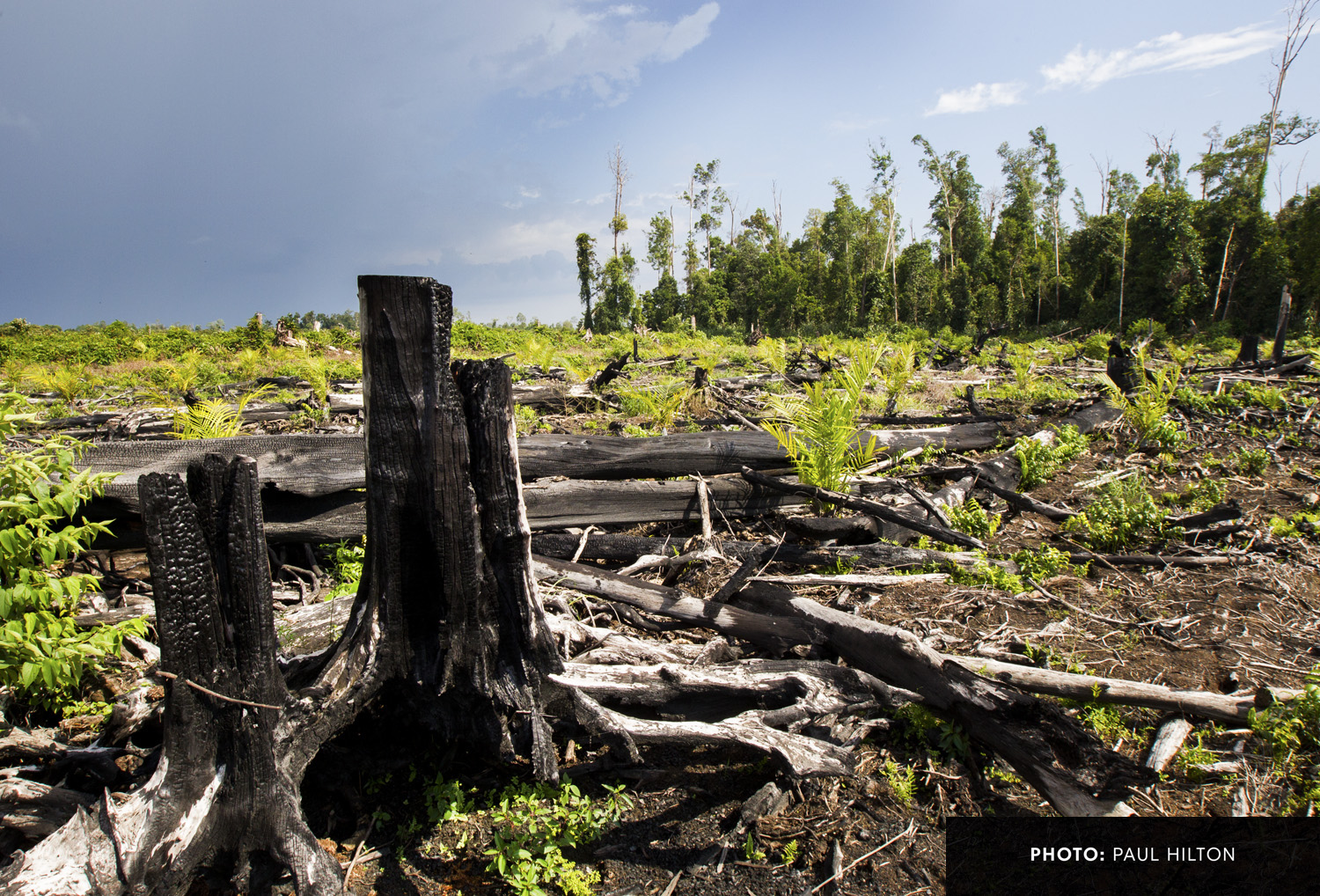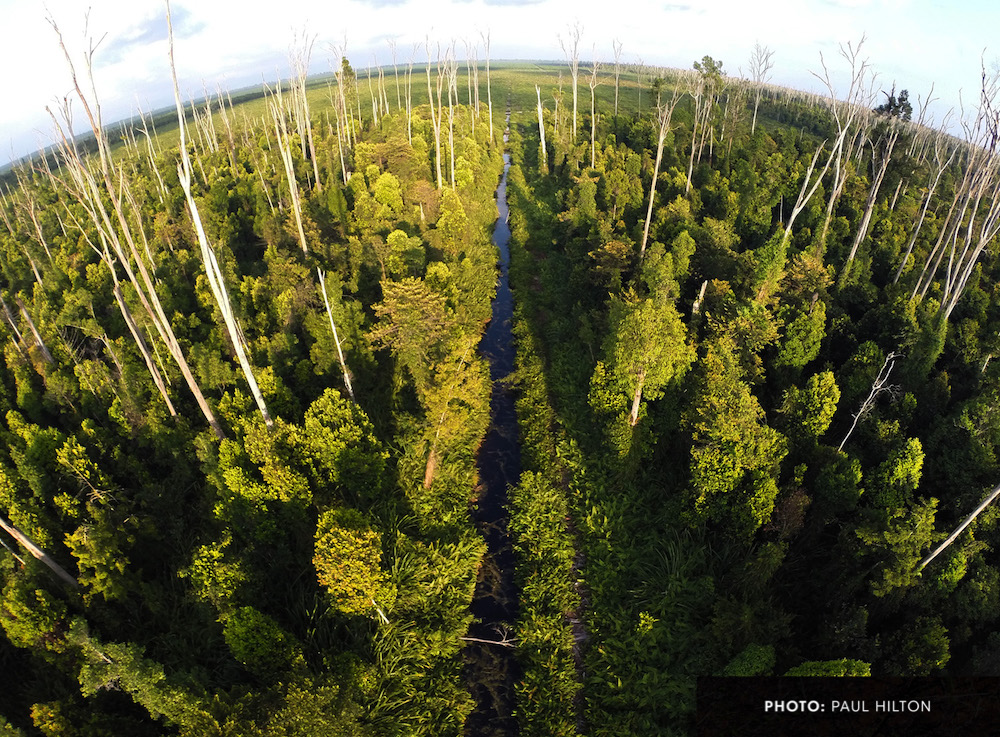The last peatland forests of the “orangutan capital of the world,” are still being destroyed in a plantation controlled by notorious palm oil company, PT. Surya Panen Subur (SPS) II.
Despite being in the international spotlight throughout the past four years for the destruction of the Tripa peatland inside the Leuser Ecosystem, field investigations and satellite monitoring reveal that peatland forests continue to be cleared in the plantation controlled by this Conflict Palm Oil culprit. This is unacceptable given the global importance of this carbon-rich peatland area. The destruction must be stopped immediately.
Satellite imagery show that around 290 acres of forest was cleared between February and August 2015:
Satellite imagery February 2015
Satellite imagery August 2015
In this map, green indicates remaining peatland forest and yellow is forest cover lost between February-August 2015.
After RAN presented evidence of clearing in June 2015, PT. SPS undertook a field investigation and claimed to not be responsible for the clearance.
But forest clearance has continued. Satellite imagery shows that an additional 183 acres of forest was cleared between August 2015 and February 2016:
Satellite imagery February 2016.
Above, green indicates remaining peatland forest and yellow is forest cover lost between August 2015 and February 2016.
Satellite imagery shows that as of February 7, 2016 four new peat drainage canals have been built, and new forest clearance has occurred since August 2015.
A field investigation in March verified these findings. Clearance and new peat drainage canals were observed near 96°32’42.106″E, 3°47’14.092″N and near 96°35’53.63″E, 3°46’53.44″N.

Recent forest clearance on PT. SPS II, February 2016. Photo: Paul Hilton
This evidence shows that either PT. SPS II is continuing to clear forested peatlands—which is illegal due to the peat depth in this area—or has failed to adequately monitor its concession and engage with other parties that are developing the land into palm oil plantations.
A vital part of the Leuser Ecosystem in North Sumatra, Indonesia, the Tripa peatland provides important habitat for some of the highest densities of critically endangered Sumatran orangutans in the world. The Sumatran orangutan is being pushed to the brink of extinction by Conflict Palm Oil expansion and is at extreme risk of becoming the first great ape to go extinct in the wild.
Additionally, the Tripa peatland helps to regulate our global climate by storing massive amounts of carbon. Although 84 percent of Tripa’s forested areas have been lost, it still harbors a relatively high carbon stock and further degradation would release a significant amount of carbon emissions. By protecting the remaining intact forested peatlands of Tripa, there is an opportunity to make significant emissions reductions.
PT. SPS II caught international attention in March 2012 when it was on fire and contributed to a man-made inferno that burned through the Tripa peatland, sending thick plumes of smoke across Sumatra. As a result, both a civil and criminal lawsuit was filed against PT. SPS II by a ministry of the central government of Indonesia. In January 2016, PT. SPS II was found guilty by the District Court of Meulaboh and ordered to pay a fine of 3 billion rupiah (around USD $226,000). PT. SPS II staff members have also been sentenced to time in prison.
In RAN’s November 2014 report The Last Place on Earth, PT. SPS II was exposed for having cleared large areas of rainforests within the Tripa peatland without the consent of local communities. Despite international pressure on PT. SPS II as a result of this report, the company was exposed the following year in another RAN report for 173 acres of new clearance.
Collective action to protect the Tripa peatland and the Leuser Ecosystem is urgently needed. PT. SPS II is a known supplier to major palm oil buyers—such as Golden Agri-Resources (GAR)—who supply palm oil to the biggest snack food brands in the world.
GAR has engaged directly with PT. SPS II since the release of RAN’s 2014 report to discuss and attempt to resolve its non-compliance issues. Since the release of RAN’s 2015 report, GAR has indicated that it worked on an action plan with PT. SPS II but the plan has not yet been published.

Peat drainage canal cutting through forested peatland in PT. SPS II, February 2016. Photo: Paul Hilton
Urgent action is needed to stop the clearance of the last forested peatlands in Tripa. It is critical that PT. SPS II, its customers including GAR, and the Aceh and Indonesian governments come together to protect and restore Tripa.
Protecting Tripa is a must if we want to stabilise our global climate. There is no further time for delays. What is needed now is urgent action. Call on the biggest buyers of palm oil from the Leuser Ecosystem to halt the bulldozers destroying Tripa and the Leuser Ecosystem.
This is one place that is simply too important to lose.
